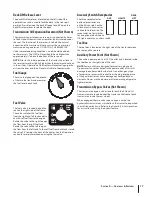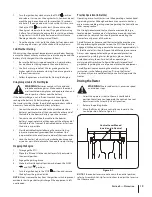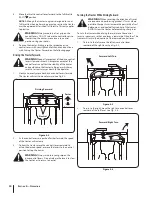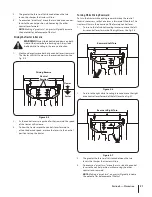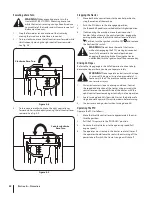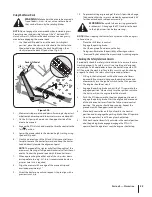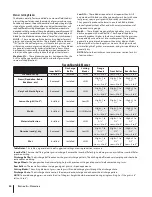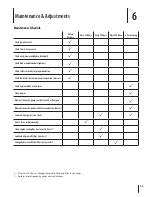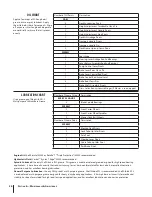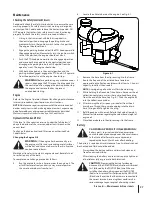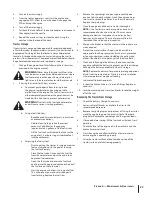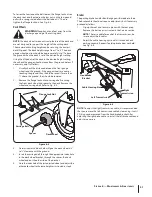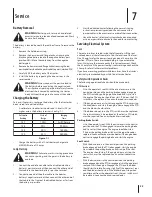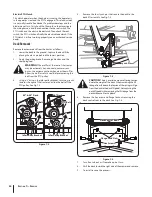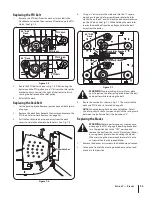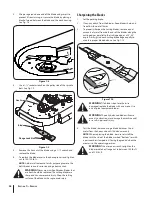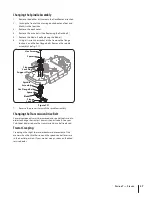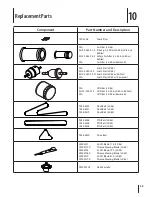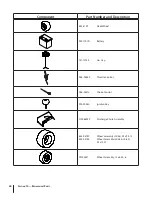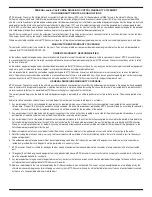
S
ection
6 — M
aintenance
& a
djuStMentS
27
Maintenance
Checking the Safety Interlock Circuits
Periodically check the safety interlock circuits to ensure they are
working properly. If a safety circuit is not working as designed,
contact you Cub Cadet dealer to have the tractor inspected. DO
NOT operate the tractor if any safety circuit is not functioning
properly. To check the safety circuits, proceed as follows:
1.
Sitting in the tractor seat with both drive pedals in
the neutral position, disengage the parking brake and
momentarily turn the ignition switch to the start position.
The engine should not crank.
2.
Engage the parking brake and pull the PTO knob upward to
the engaged position. Momentarily turn the ignition switch
to the start position; the engine should not crank.
3.
Push the PTO knob downward to the disengaged position
and move both drive pedals to the neutral position and
disengage the parking brake; then lift upward from the
operator’s seat. The engine should stop.
4.
With both drive pedals in the neutral position and the
parking brake engaged, engage the PTO knob. Lift upward
from the operator’s seat; the engine should stop.
WARNING!
Before performing any maintenance or
repairs, disengage the PTO, move the drive pedals to
the neutral position, engage the parking brake, stop
the engine and remove the key to prevent
unintended starting.
Engine
Refer to the Engine Operator’s Manual for all engine maintenance
intervals, procedures, specifications and instructions.
NOTE:
Maintenance, repair, or replacement of the emission control
devices and systems which are being done at owner’s expense may
be performed by any engine repair establishment or individual.
Warranty repairs must be performed by a Cub Cadet Dealer
.
Hydraulic Oil Tank and Filter
If the level in the expansion reservoir under the falls below 1⁄4”
above the bottom of the reservoir, add oil until it reaches the
correct level.
To change the hydraulic oil and filter, see an authorized Cub
Cadet Dealer.
Changing the Engine Oil
WARNING
! If the engine has been recently run,
the engine, muffler and surrounding metal surfaces
will be hot and can cause burns to the skin. Exercise
caution to avoid burns.
Maintain oil level as instructed in engine manual. Be careful not
to spill oil on any of the belts.
To complete an oil change, proceed as follows:
5.
Run the engine for a short time to warm the engine oil. The
oil will flow more freely and carry away more impurities.
Use care to avoid burns from hot oil.
6.
Locate the oil drain hose on the engine. See Fig. 6-1.
Figure 6-1
7.
Remove the hose from the clip securing it to the frame.
8.
Route the free end of the oil drain hose toward an
appropriate oil collection container with at least a 2.5 quart
capacity, to collect the used oil.
NOTE:
Avoid getting oil on the muffler when draining.
9.
While holding the free end of the oil drain hose over the oil
collection container, unscrew the square-head hose plug
from the end of the hose. See Fig. 6-1. Drain the engine oil
into the collection container.
10.
After draining the oil, wipe any residual oil from the oil
drain hose. Thread the square head plug into the drain
hose fitting and fully tighten the plug.
11. Refill the engine with new oil. Refer to the Engine Operator’s
Manual for information regarding the volume and weight of
engine oil.
12.
Place the hose back into the clip securing it to the frame.
Battery
CALIFORNIA PROPOSITION 65 WARNING
!
Battery posts, terminals, and related accessories
contain lead and lead compounds, chemicals known
to the State of California to cause cancer and
reproductive harm. Wash hands after handling.
The battery is sealed and is maintenance-free. Acid levels cannot
be checked and fluid can not be added.
•
Always keep the battery cables and terminals clean and
free of corrosive build-up.
•
After cleaning the battery and terminals, apply a light coat
of petroleum jelly or grease to both terminals.
CAUTION:
If removing the battery for cleaning,
disconnect the NEGATIVE (Black) wire from its terminal
first, followed by the POSITIVE (Red) wire. When re-
installing the battery, always connect the POSITIVE
(Red) wire its terminal first, followed by the NEGATIVE
(Black) wire. Be certain that the wires are connected to
the correct terminals; reversing them could result in
serious damage to your engine’s alternating system.





